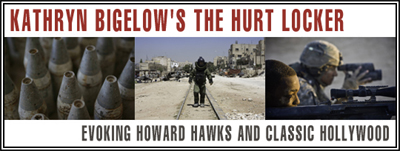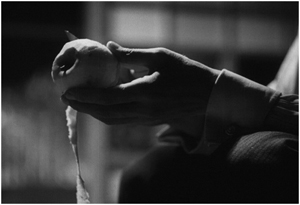For Your Consideration 2009 Campaign - Best Director
KATHRYN BIGELOW’S THE HURT LOCKER:
Evoking Howard Hawks and Classic Hollywood
Every few years there are some American films that recall the traditions of the old-fashioned Hollywood studio days auteurs such as John Ford, Alfred Hitchcock, William Wyler, Frank Capra, and of course Howard Hawks. Paul Thomas Anderson’s 2007 film There Will Be Blood showed a vast influence of Hollywood studio influence from the silent era to Orson Welles and Stanley Kubrick; Woody’s Allen move to England with Match Point in 2005 brought him closer to Hitchcock; 2004’s Million Dollar Baby re-imagined the film noir in a heartbreaking modern tale; Michael Clayton (2007) and Rachel Getting Married (2008) each echoed the sprit of the 1970s in different cinematic styles.
Now arrives Kathryn Bigelow’s Iraq-war based film The Hurt Locker, which may evoke the old fashioned Hollywood studio filmmaking with more assurance then any film released in the past decade. Long underrated as a gifted filmmaker, lets hope this film earns Bigelow the recognition she so fully deserves. Bigelow has made some fine films but with The Hurt Locker she is at her artistic peak –particularly because of the complete control she possesses over the filmmaking.
She places emphasis of aesthetics over politics or messages. She finds the sensibilities few war films capture, notably in honest characterization. Above all, this is the characters of the film – not what they do in the face of battle and pressure, but how they do it. It is this understanding that considers Bigelow a modern Howard Hawks – a master not only of narrative rhythm, but also of character and of action, and most specifically a master of showing without telling. Hawks and Bigelow have the awareness not to lose sight of the narrative flow or of the characters.
One of Bigelow’s long occurring themes as filmmaker has been men placed in the face of high-pressure situations. As Sergeant William James, actor Jeremy Renner perfectly defines the essential Hawksian hero who is at his best when doing his job. His courage comes from a calm acceptance and understanding of fear and pressure. It is how he does his job that will define whether or not he lives or dies and this is where Bigelow’s interest lies. It is the suggestive scene in which we observe William away from severe duties (at home in the supermarket) that we see him perplexed to make decisions. His place is in the “kill zone” for as the films opening quotation observes: “The rush of battle is often a lethal and potent addiction, for war is a drug.”
As a film The Hurt Locker is a simply a flawless and original achievement in tense action cinema. It is a full experience of senses both for its stillness and its harrowingly intense ferocity. It is truly a joy to see films like this still being made today.
Evoking Howard Hawks and Classic Hollywood
Every few years there are some American films that recall the traditions of the old-fashioned Hollywood studio days auteurs such as John Ford, Alfred Hitchcock, William Wyler, Frank Capra, and of course Howard Hawks. Paul Thomas Anderson’s 2007 film There Will Be Blood showed a vast influence of Hollywood studio influence from the silent era to Orson Welles and Stanley Kubrick; Woody’s Allen move to England with Match Point in 2005 brought him closer to Hitchcock; 2004’s Million Dollar Baby re-imagined the film noir in a heartbreaking modern tale; Michael Clayton (2007) and Rachel Getting Married (2008) each echoed the sprit of the 1970s in different cinematic styles.
Now arrives Kathryn Bigelow’s Iraq-war based film The Hurt Locker, which may evoke the old fashioned Hollywood studio filmmaking with more assurance then any film released in the past decade. Long underrated as a gifted filmmaker, lets hope this film earns Bigelow the recognition she so fully deserves. Bigelow has made some fine films but with The Hurt Locker she is at her artistic peak –particularly because of the complete control she possesses over the filmmaking.
She places emphasis of aesthetics over politics or messages. She finds the sensibilities few war films capture, notably in honest characterization. Above all, this is the characters of the film – not what they do in the face of battle and pressure, but how they do it. It is this understanding that considers Bigelow a modern Howard Hawks – a master not only of narrative rhythm, but also of character and of action, and most specifically a master of showing without telling. Hawks and Bigelow have the awareness not to lose sight of the narrative flow or of the characters.
One of Bigelow’s long occurring themes as filmmaker has been men placed in the face of high-pressure situations. As Sergeant William James, actor Jeremy Renner perfectly defines the essential Hawksian hero who is at his best when doing his job. His courage comes from a calm acceptance and understanding of fear and pressure. It is how he does his job that will define whether or not he lives or dies and this is where Bigelow’s interest lies. It is the suggestive scene in which we observe William away from severe duties (at home in the supermarket) that we see him perplexed to make decisions. His place is in the “kill zone” for as the films opening quotation observes: “The rush of battle is often a lethal and potent addiction, for war is a drug.”
As a film The Hurt Locker is a simply a flawless and original achievement in tense action cinema. It is a full experience of senses both for its stillness and its harrowingly intense ferocity. It is truly a joy to see films like this still being made today.



